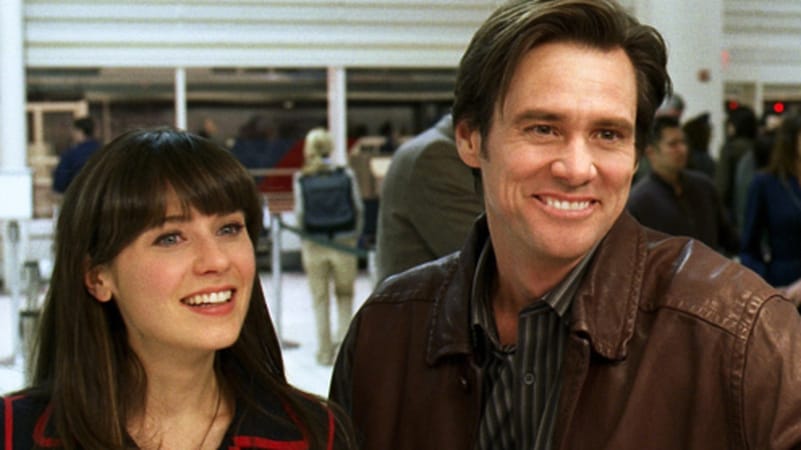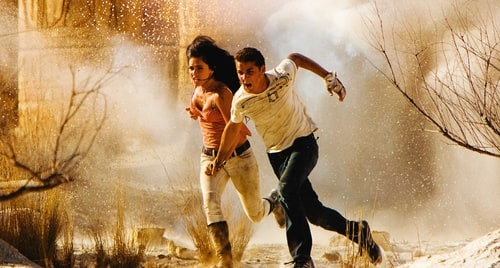Easily the purest Sam Raimi movie since Evil Dead II, Drag Me to Hell is a triumph - one of the best movies of 2009. This horror tour de force is precisely the movie needed to revitalise the genre after a string of superfluous remakes (The Grudge, One Missed Call) and torture porn features (Saw, Hostel). Best of all, Drag Me to Hell allows Raimi the opportunity to reawaken his visceral horror instincts that were mummified by the big-league, big-budget Spider-Man trilogy. Even with the teen-friendly PG-13 rating in place, this is classic Raimi. So why is this PG-13 horror romp a rousing success while other modern horrors fall flat? Two factors stand out - Raimi's respect for his audience, and his desire to make horror fun again. In trademark Raimi style, Drag Me to Hell lurches from wild laughs to beautifully choreographed scares with a steady sleight of hand. The story is basic, the gimmicks are familiar and the mythology is laughable, but Raimi is highly confident with what he's presenting. This is a movie which demands to be seen with a large audience, milking every gasp and laugh for the best experience.
Drag Me to Hell begins with the decades-old Universal Studios logo, establishing a sense of nostalgia to get the audience in the mood for what follows. This old-fashioned exercise in terror transports an audience back to an era when horror was all about providing a fun, suspenseful carnival ride of fright flick...before torture porn tendencies clogged up vital artistic arteries.
Following an insanely atmospheric pre-title sequence, we're thrust right into the primary story. Christine Brown (Lohman) is a bank loan officer vying for a promotion against a brown-nosing colleague (Lee). In order to receive this promotion, she's told she has to be able to make the "tough decisions". Thus, when the normally soft-centred Christine is approached by aging gypsy Mrs. Ganush (Raver) who asks for a third extension on her mortgage payment, she denies the request. And for this, there is literally hell to pay. Things slowly go downhill for Christine from there as she finds herself the recipient of a supernatural curse placed on her by Mrs. Ganush. The shadowy demon haunting Christine begins toying mercilessly with her, and after three days she'll be dragged down to Satan's dominion.
Drag Me to Hell provides a thin membrane of a plot, quickly setting up Christine's workplace ambition and demonic dilemma which leaves plenty of time for Raimi to torment his heroine in creative ways. Naturally the film is more about the tour de force terror sequences, of which there are plenty. The film's biggest blessing is its humour, which ranges from one-liners to a hilariously awkward dinner scene during which Christine meets her boyfriend's parents. But the best moments occur when the horror elements combine with this humour, and you begin laughing in a combination of terror and delight. If you're not laughing with every scream, you're only getting half the experience. Raimi has an uncanny knowledge of what his audience really wants, ratcheting up the tension when necessary and keeping things moving at a perfectly brisk pace. He even has the good grace to add an extra scare when the pace slows down. In the tight 95-minute running time, not a moment feels wasted.
Raimi isn't too interested in extravagant bloodshed as he frequently uses booming sound effects to generate a mood of inexorable unease instead. This isn't a lazy director hitting the cheap scare button...this is Sam Raimi, and he's a horror maestro. Anyone concerned that Raimi didn't go all the way with this one due to the big studio backing - and worse, the dreaded PG-13 rating - can easily put their fears to rest. There's less blood, but there are some gruesome moments and the bodily fluids flow freely, not to mention the scares are continually thrown at you. Drag Me to Hell is one of the loudest movies of recent memory. Raimi wants the viewer to experience Christine's physical torment through the raucous soundtrack, giving the director a chance to spotlight his Evil Dead roots. The grandiose score courtesy of Christopher Young is the cherry on top.
Most welcome is Raimi's refusal to turn Drag Me to Hell into a CGI-fest of a horror film, instead relying on more traditional effects. It's amazing how much mileage Raimi is able to get out of an acrobatic camera, canted angles, old-fashioned make-up effects and a couple of shrieking possessed people suspended on wires. It's exciting to behold a film released in 2009 that benefits from the vitality of practical effects along with the judicious use of digital effects when appropriate. The CGI is admittedly a tad cheesy, but intentionally so - it adds to the camp appeal.
Although this isn't a message film, Drag Me to Hell can be perceived as a cautionary tale about the perils of greed (rather similar to Raimi's own A Simple Plan). Christine's one concession to ambition is enough to damn her to a horrific ordeal. The film's release is rather timely - with the world in an economic crisis, audiences can be expected to enjoy watching a banker suffer.
Alison Lohman stepped into the shoes of Christine Brown when Ellen Page dropped out during pre-production due to scheduling difficulties. Lohman is no Bruce Campbell, but she nimbly succumbs to a Raimi horror beatdown (being tossed around like a projectile ragdoll time and time again) while retaining much of her natural charisma. She does an amazing job with what is usually a thankless horror victim role, managing to be both in on the joke and sincere without tipping her hand either way. As the vengeful gypsy women, Lorna Raver is disgusting and formidably menacing. Justin Long is also good as her comic relief boyfriend, while new faces like Dileep Rao leave a big impression. Character development is a huge positive factor here - all key characters are fleshed out and developed wonderfully, which is amazing for a horror film. Granted, the acting is somewhat hammy and the dialogue can be tin-eared, but this suits the film's style.
Some simply won't get what Sam Raimi was trying to do with Drag Me to Hell. For everyone else, this is an absolute blast. You'd have to be crazy to pass up the opportunity to see this nuanced symphony of the macabre. The trailer was correct about one thing: this is a return of true horror. It's also the return of true Raimi, and it's great to have him back.
9.1/10
 Login
Login
 Home
Home 183 Lists
183 Lists 1664 Reviews
1664 Reviews Collections
Collections
 0 comments,
0 comments, 














